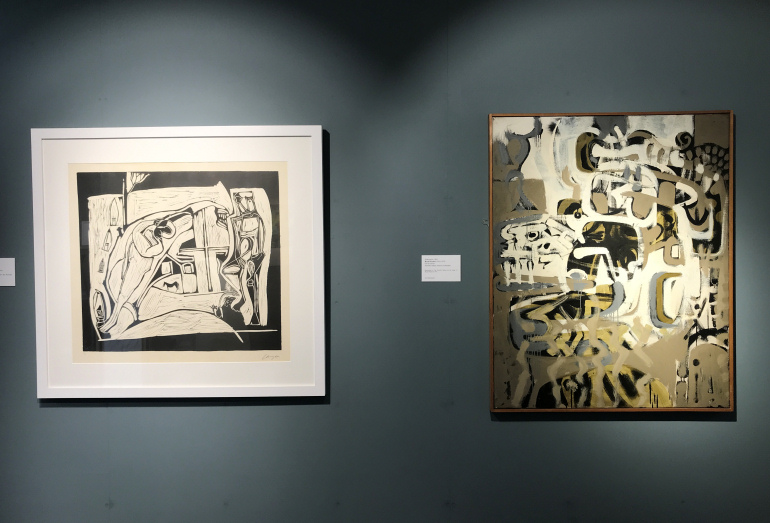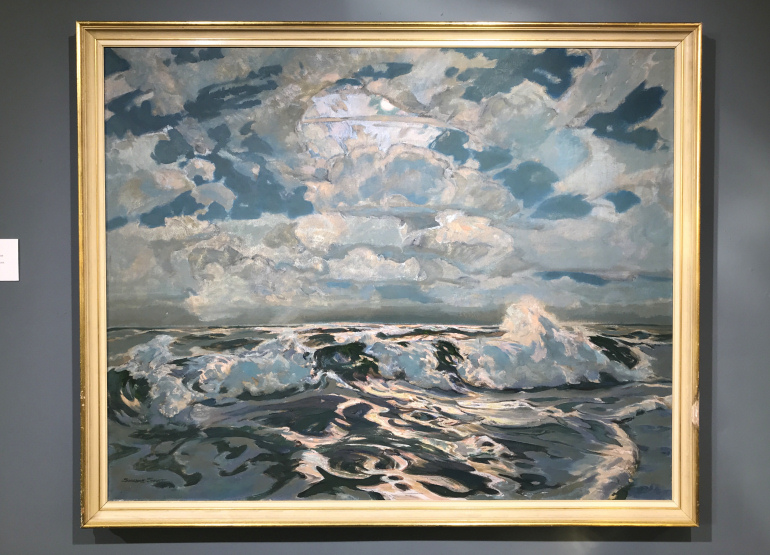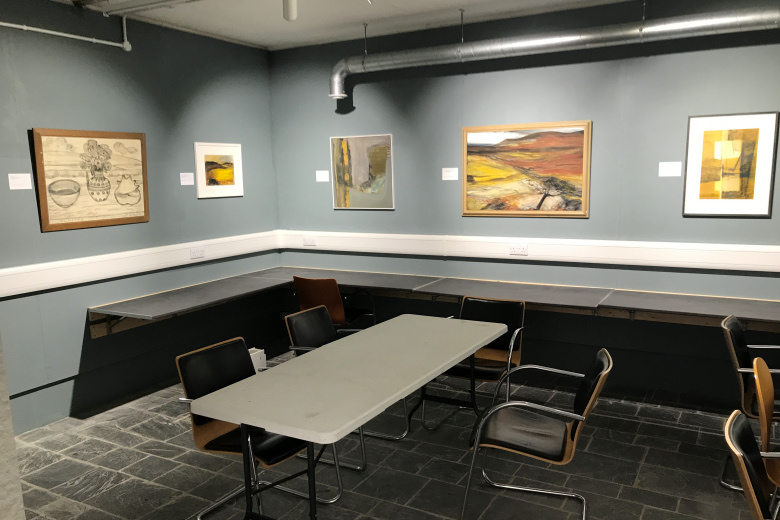|
Jason Lilley on
The Penwith Society and the new Penwith Gallery archive
Rupert White
goes on a guided tour of the Penwith Gallery with Jason Lilley, artist
and archivist.
There's
been a few changes at the Penwith Gallery recently. Shall we talk about
them?
Yes. We're basically trying to turn a very old building into a
functioning, contemporary gallery. And thanks to the
generosity of our Vice Chair, sculptor Tom Leaper, we've been able to
update the lighting, sculpture garden and to afford to put a new glass
roof in the main gallery.
This bookshop space has always been here, but it
certainly looks cleaner and
brighter than it used to be.
This is the sort of 'bread and milk aisles'. This is the stuff that
ticks over and gets the money. The Tate's bookshop is n't what it use to
be...

Yes. It's become rather generic.
They won't stock Margaret Gardiner's
book on Barbara Hepworth because it mentions that she joined the
Communist Party! It's crazy.
We're going to get rid of the kitchen area and
basically turn it into a bookshop, with
pottery and jewellery and the crafts. Just so people can get something
different.
Coming on to The Hepworth Room, which is a
newish exhibition space (picture below).
Presumably it has a gradually changing historical exhibition?
Yes. This is the area me and Julia, my wife, are in control of. What we do is beg
borrow and steal - though not so much steal these days - but we go to
people like The Belgrave Gallery, Porthminster Gallery and other
individuals and ask to show their art works
alongside our own collection.

So
you've got a nice Bryan Wynter in here
(picture below right)...
This was actually found in two inches of water by myself. I unwrapped it
and I saw this little corner here and I thought 'oh my God I know that's
a Bryan Wynter because of the colours and the frame', and my knees started to knock
together!
We've also got a
Victor Pasmore. We had our eyes on this for quite a while. The only
downside was that I had to carry it from
Porthminster Gallery, through St. Ives,
to here on my
shoulders!
The big Hepworth sculpture,
'Magic Stone' (above), was near the front door
for a while wasn't it?
It was in the foyer. It's Seravezza
stone. It was given to the gallery for purposes of promotion
on the understanding that if we
ever didn't want it it would revert to the estate. But it never will be
returned to the estate because we love it! It
costs us six grand insurance a year, but it's
well worth it and it's the only 'Magic
Stone' that doesn't have a hole in it.
That's interesting.
And for Barbara to be given the honour of
using the marble from Michelangelo's quarry is quite
important.

The base of 'Magic Stone' is made of guarea wood which is a North
African wood. Many of Barbara's bases are made from guarea wood. She gave
some to John Milne and Denis Mitchell. The story goes that Margaret Gardiner went on holiday with her to North
Africa and the Mediterranean, Barbara saw the wood and said 'this would
make nice carvings'. And Margaret goes 'oh,
don't worry, darling. I'll get you some'. Anyway, Barbara got a
phone call from Portsmouth docks about six months later to say
'your
wood's here'. Turned out it was still a tree! So she had to send a tree
surgeon to chop it up, and the delivery was so big it blocked the roads
for hours in St Ives...
We also get donations, like the Sven Berlin and the Borlase Smart
(below). Borlase Smart died in 1947, and that's when all the
trouble started. Bradshaw said that he ran with the foxes and the
hounds.
He helped keep the St Ives Society together during the war.
But after he died the in-fighting started...Bradshaw and Rowntree and
Ninnes didn't like
the way the society was going. Bradshaw hadn't been chosen for an
exhibition and I think Ben Nicholson had been chosen, and Bradshaw
didn't appreciate that. And he thought that the chairman Leonard Fuller,
and David Cox, the secretary were basically
pushing towards a more modernist ideology. And so they called a meeting,
and that's when the split happened.

People think that the Penwith Society is a modernist society, but
nothing could be further from the truth. It did have modernists in it,
but of the first 19 that left the St Ives Society to form the Penwith
Society, in February 1949, only 8 were modernist. The other 11 were just
sympathisers. And at the first meeting Peter Lanyon
insisted that the society be a catholic society - not big 'C',
like David Cox wrote, but a small 'c' - so there was a broad spectrum of
artists. There was no segregation whatsoever.
But that only lasted a couple of months. After
the first show the hang committee hadn't done a very good job and
certain people said, 'we've got to segregate'. So it became A)
traditional B) modernist and C) craft. Basically, from that moment on,
the society struggled. Poor old Karl Weschke
was put into group B). And in his notes, he asks 'do I have to always be
abstract now?' Looking through the minutes,
it's like watching a slow train crash! The system of
segregation lasted until the late '70s.
This Sven drawing was donated to us. The lovely Ian
Massey gave us this Alan Lowndes. The Paul
Feilers were donated by Paul to pay for the front door. They didn't
sell, but they were given to the gallery.
The
Penwith Gallery now has two main spaces, were'nt they car parks
originally?
The Hepworth Room is here, in the new gallery
space,
built from 1971 onwards. The main gallery
on the other side is the original space bought
in '61, thanks to a
Gulbenkian fund,
for four and a half thousand pounds. It
was a pilchard packing factory and this side
was a car park, but it too
was a pilchard packing factory before
it was car park.
Above us is a row of fisherman's cottages.
They got a quote for £40,000
to convert the car park, which is a lot
of money in early 70s, but it rocketed up to
£140,000 and that really crippled the society.
And yeah, rather than these granite posts the
carpark was held up by acrow props.
If the
main gallery opened in '61,
that means that there was a period of more than ten years when
the Penwith Gallery was in
the centre of St Ives, in
Fore Street.
It was in two places in Fore Street. First of all, in
'49 when they met in the Castle Inn,
the Labour Party were vacating their space,
the meeting hall, which was above the Castle
Inn so that was their first venue
for exhibitions. It was quite small.
But then they moved to 36, Fore Street which
is a Joules shop now,
opposite a camera shop.

Tony Shiels had his gallery, the Steps Gallery, above there.
There were a lot of galleries around, and
basically if a shop had a bit of space there'd
be an exhibition. The first opportunities for
Bryan Wynter and Peter Lanyon were in
Downing's bookshop.
Moving to the back of the 1971 gallery space, there are two new
locked rooms.
Last year we made a study room
(picture above) for the academics and students
who come to us, and we have meetings in here
as well. And again, we
put little exhibitions of the Penwith's
archive collection in here, which is nice
because you do see some
lesser known names.
We found an absolute ton of artworks in the
room where there was a lot of water damage.
We found a Bryan
Pearce (picture below), and this is a Rose
Hilton. Rose hadn't signed it or dated it. When she came into the
gallery I went up to her and said. 'Rose I think this is yours. Is it?'
She said 'Oh yes, I painted it in '73'. These were all in plastic bags
in two inches of water in a dumping room out the
back. Fortunately Cathy Watkins didn't
throw anything away. The problem is we have to put up with about 25
recipes for coronation chicken!

If I could set the scene. It was pitch darkness. You couldn't see your
hand in front of your face. I was wearing flip-flops
and I already had wet feet. I put my hands
into the first bag, pulled out a piece of
paper, took it outside, and
started reading it. It was a letter from Wilhelmina Barns-Graham
saying how cold it was in Scotland and how she wished she was back in
Cornwall. And she'd done a little drawing of her trudging through the
snow with her scarf waving behind. I thought 'that's
precious. That's
nice'. Anyway, I went back, put my hand in the same bag and pulled out a
telegram from Peter Lanyon. And it said
'sorry, I can't make Saturday's meeting. Could
David Haughton, please proxy for me. And if
David can't do it, anybody but Barbara or Ben?'
and the hairs on the back of my head shot up. My
knees started quaking again and I thought, oh my god, what have I found?
Amazing. But
it sounds like it was all
very jumbled up. So basically what you've done is
to sort them into boxes to
keep them safely in the archive room.
Yes. I contacted the National Archives and I
said to my wife 'let's see how long it takes
them to respond and see how important this is'.
Within 20 minutes we got an eight page reply, with
lots of advice. Then they sent two of the most fantastic people
down and we basically moved all the stuff out of the water into a
studio.

Now its here, in this
tighter, more enclosed space. And
you've got two dehumidifiers
going...
The humidity in here ran at 86%.
Now, anything over mid 50s and mould will start to appear. I
personally paid for the
first dehumidifier, the
shelving units and the boxes, basically. I
knew the stuff that was here could eventually be of interest to
academics, and to students
and families that have been here.
So do
you think the oldest
materials are the
minutes of the Society, going back to the 40s
and 50s?
Yes. Here's the first meeting of the Penwith
Society in 1949. And these are the 19 that
started (picture below). So if anybody says
'oh yeah, I was a founding member'
we can check because we've
got the list! Garlick
Barnes used to think that
she was a founding member, but sadly not, though she was a member within
the month.
That meeting would have been in The
Castle because Denis Mitchell's brother was
the landlord and so it was
the perfect place to go, even though
Ben Nicholson was teetotal. He didn't really want to meet up in any
establishment that sold alcohol. Before they
rented out the hall above the Castle Inn, they went to St. Christopher's
which was a restaurant on Porthmeor Road. Just
around the corner here.

The Val Baker's place.
Yes, but
they came a bit later, after the Keeley's had it.
Ben felt quite
righteous that there was no alcohol. Much to the annoyance everybody
else, probably!
Regarding your other activities at the
gallery, I noticed recently that an
Art
History Club has started up.
Alice Ellis Bray. Fantastic artist and fantastic person and she works with us.
The sun was shining when she decided to join
us! She's set up this art history club.
The thing is we're completely unfunded. The Tate and Leach take
everything in St. Ives and nobody wants to give grants to us, which is
why I had to buy all the storage material
myself.
You've got an Instagram account
running for the archive, but presumably only a
very small fraction of the archive has gone
onto that.
Yes. There are seventy boxes and each piece of
paper, apart from the coronation chicken, is extremely relevant.
Recently Matt Retallack,
art historian, came in researching the
sale of St Peters Loft, with Peter Lanyon's
school above, for example.
And now your book is in the archive too.
I
feel honoured.
@penwithgalleryarchive
@artisthistoryclub
www.jasonlilley.com
30.4.23. |








